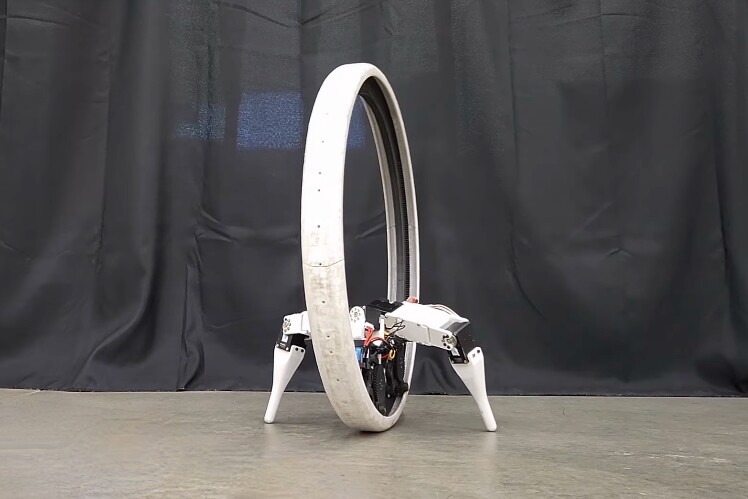Inspired by the wheel-bodied battle droids from Star Wars, a scientist has created a robot that rolls along on one big wheel, using extendable legs to steer. Instead of smashing the Rebel Alliance, however, this bot's nimble descendants may one day be making deliveries.
The small-scale prototype robot is known as the Ringbot, and it was designed by Assoc. Prof. Joohyung Kim and colleagues at the University of Illinois Urbana-Champaign.
Kim was inspired not only by Star Wars but also by the various full-size monowheels that have been created over the years.
In a nutshell, a monowheel is a vehicle in which the rider sits on a motorized platform mounted on a ring-shaped rail – that rail forms the inside of a single big wheel. The platform stays level with the ground as the wheel rolls around it, moving the vehicle forward.
In fact, Kim also took inspiration from "wheeled-foot" robots such as ETH Zurich's ANYmal, which has motorized wheels on the ends of each of its four legs. On smooth surfaces, those wheels move the robot along quickly and efficiently, like a car. On uneven terrain, however, the wheels lock up to serve as feet while the robot walks.

The Ringbot incorporates a 515-mm-diameter wheel consisting of a nylon/carbon composite rim clad in a solid elastomer tire. Sitting one-in-front-of-the-other inside the rim (at the bottom), are two motorized driving modules.
Those modules are connected to one another via a stretchable curly cord, and they engage the surface of the rim via little cog wheels of their own. Each module also has an articulated robotic leg on top, which can extend out to the side pointing up or down.
As the modules spin up their cogs, they cause the Ringbot's wheel to rotate around them – they're described as being like two hamsters running in an exercise wheel.
They automatically adjust the distance between themselves in order to change the robot's lateral center of mass as needed, for maintaining balance while traveling at different speeds. When it's time to turn left or right, one or the other module will extend its leg outwards to shift the bot's balance to that side.
The legs can additionally be deployed down to the ground in order to hold the Ringbot up when it's stopped, and to turn it around on the spot before it resumes travel. They also keep it from falling over if it loses its balance, just like a motorcycle rider will put a foot down on the road. The legs can even stand the robot back up if it ends up lying flat against the ground on one side.

In indoor tests conducted so far, the Ringbot was remotely controlled by a human operator, who took it up to its top speed of 5 km/h (3 mph).
Down the road, however, a much faster and larger successor to the bot may utilize cameras, sensors and GPS to autonomously thread its way through traffic on crowded city streets, delivering items to businesses or individuals. That version may also have four wheel-footed legs, allowing it to walk like the ANYmal when going up stairs or traversing obstacles.
"In big cities, many bikes and motorcycles navigate through traffic to fulfill delivery needs, thanks to their ability to maneuver through narrow spaces," said Kim. "We plan to enhance Ringbot's capabilities specifically for last-mile deliveries in congested settings, aiming to automate and optimize delivery processes."
You can see the Ringbot in action, in the video below. A paper on the research, which was partially funded by the Hyundai Motor Group, was recently published in the journal IEEE Transactions on Robotics.






